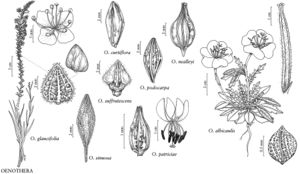Oenothera sinuosa
Syst. Bot. Monogr. 83: 214. 2007.
Herbs perennial, usually glabrous, sometimes strigillose and villous, hairs erect; from a woody taproot but spreading by rhizomes (forming extensive colonies). Stems erect, branched below and just above ground, branched also proximal to inflorescences, 40–120 (–250) cm. Leaves in a basal rosette and cauline, (1–) 3–11 × (0.1–) 0.5–2 cm, blade linear to narrowly oblanceolate, margins usually sparsely sinuate-dentate, rarely subentire, often undulate. Inflorescences stout. Flowers 4-merous, zygomorphic, opening near sunset; floral-tube 2.5–5 mm; sepals 7–14 mm; petals white, fading pink to red, slightly unequal, elliptic, 7–15 mm; stamens presented in lower 1/2 of flower, filaments 5–11 mm, lanate at very base, anthers 3–5 mm, pollen 90–100% fertile; style 12–19 mm, stigma exserted beyond anthers at anthesis. Capsules narrowly ovoid, narrowly 4-winged or 4-angled, 8–15 × 1.5–3.5 mm, abruptly constricted to a long, sterile stipe 2–8 mm. Seeds (1 or) 2–4, light to reddish-brown, 2–3 × 1–1.5 mm. 2n = 28.
Phenology: Flowering Apr–Aug.
Habitat: Flats and washes in light sandy loam.
Elevation: 0–300(–1300) m.
Distribution
Ala., Ark., Calif., Fla., Ga., Mo., N.Y., Okla., Tex., in Europe (Italy), s Africa
Discussion
P. H. Raven and D. P. Gregory (1972[1973]) determined Oenothera sinuosa to be self-incompatible.
Oenothera sinuosa is endemic to Oklahoma and Texas and is escaped or naturalized in Alabama, Arkansas, California (where found to 1300 m), Florida, Georgia, Missouri, and New York.
Oenothera sinuosa is potentially a noxious weed due to the aggressive rhizomatous habit, but is somewhat limited by its self-incompatibility. Molecular data (G. D. Hoggard et al. 2004) are consistent with the hypothesis that the allotetraploid (2n = 28) O. sinuosa arose by interspecific hybridization of two species within subsect. Stipogaura as suggested by P. H. Raven and D. P. Gregory (1972[1973]). The molecular data indicate that the pistillate parent came from O. calcicola or a close relative, while the staminate parent originated from the lineage that gave rise to O. cinerea and O. filipes.
Selected References
None.
